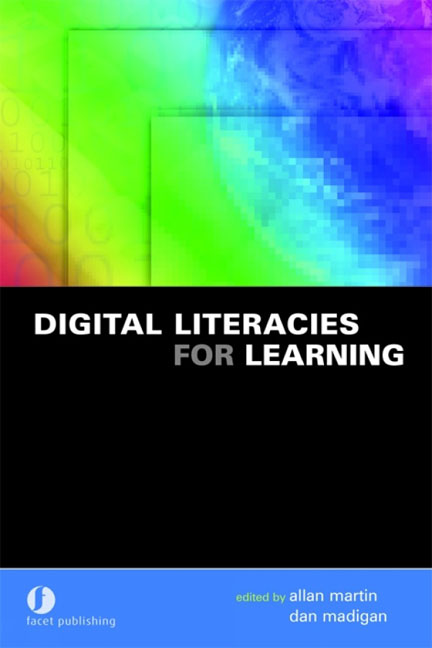Book contents
- Frontmatter
- Contents
- Dedication
- The contributors
- Foreword
- Preface
- Part I Literacies in the digital age
- 1 Literacies for the digital age: preview of Part 1
- 2 Learners, learning literacy and the pedagogy of e-learning
- 3 Real learning in virtual environments
- 4 Digital fusion: defining the intersection of content and communications
- 5 Literacy and the digital knowledge revolution
- 6 Understanding e-literacy
- 7 Information literacy – an overview
- 8 Contemporary literacy – the three Es
- 9 Reconceptualizing media literacy for the digital age
- 10 Literacy, e-literacy and multiliteracies: meeting the challenges of teaching online
- 11 Graduate e-literacies and employability
- Part II Enabling and supporting digital literacies
- Index
10 - Literacy, e-literacy and multiliteracies: meeting the challenges of teaching online
from Part I - Literacies in the digital age
Published online by Cambridge University Press: 08 June 2018
- Frontmatter
- Contents
- Dedication
- The contributors
- Foreword
- Preface
- Part I Literacies in the digital age
- 1 Literacies for the digital age: preview of Part 1
- 2 Learners, learning literacy and the pedagogy of e-learning
- 3 Real learning in virtual environments
- 4 Digital fusion: defining the intersection of content and communications
- 5 Literacy and the digital knowledge revolution
- 6 Understanding e-literacy
- 7 Information literacy – an overview
- 8 Contemporary literacy – the three Es
- 9 Reconceptualizing media literacy for the digital age
- 10 Literacy, e-literacy and multiliteracies: meeting the challenges of teaching online
- 11 Graduate e-literacies and employability
- Part II Enabling and supporting digital literacies
- Index
Summary
Abstract
Online teaching and learning are challenging for both teacher and student. There are differences to be negotiated in the modes of learning and communicating and in the language of the technology, the language of the learning environment and the contextspecific language of the subject/vocation. It is estimated that there are at least seven literacies involved in teaching and learning in the online environment. Online learners in Australia are predominately middle-aged women; this is the group that is most likely to have problems with multiliteracies and particularly e-literacy. Even more concerning, this is the group in vocational education and training (VET) that is also likely to be asked to teach online. When both teacher and learner have difficulties with multiliteracies and e-literacy, there is a detrimental effect on the e-learning experience. This may contribute to the high attrition rates experienced in online courses and the reluctance of teachers to take up flexible-learning options. The Australian VET sector has taken some innovative approaches to materials development that are successfully meeting the challenges of multiliteracies.
Introduction
The Australian vocational education and training (VET) sector gives Australians the opportunity to gain the skills they need to enter the workforce for the first time, to re-enter the workforce, to retrain for a new job or to upgrade their skills for an existing job. More than 1.7 million students or about 13% of the working- age population take part in VET each year. In order to support and encourage a growing demand by learners for more flexible learning in VET, the Australian Flexible Learning Framework (AFLF) 2000–2004 invested millions of dollars in professional development for early adopters and in the production of high-quality e-learning materials to support the sets of Australian quality framework competencies known as training packages. However, despite the availability of such wonderful resources, e-learning has not been taken up on the scale that was expected.
Problems with e-learners and e-learning
I believe that one of the reasons for this is the lack of digital competence and multiliteracies among both learners and teachers in all sectors of education in general and in VET in particular. Traditionally, learners in the VET sector were apprentices and trainees in industry. They were most likely to be 15–18-year-old school-leavers, going straight from secondary education to trade training.
- Type
- Chapter
- Information
- Digital Literacies for Learning , pp. 110 - 122Publisher: FacetPrint publication year: 2006



